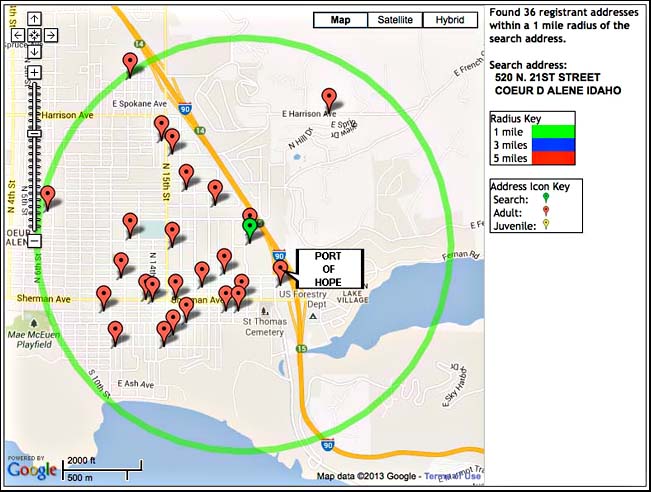 During the Port of Hope’s hearings before the Coeur d’Alene City Planning Commission, some people expressed opinions that Port of Hope’s presence has jeopardized the safety of the community by providing transitional housing to registered sex offenders (RSO). To listen to them, Port of Hope is to blame for the presence of most of the RSOs near Fernan Elementary School and in the downtown flophouse motels. That’s nonsense.
During the Port of Hope’s hearings before the Coeur d’Alene City Planning Commission, some people expressed opinions that Port of Hope’s presence has jeopardized the safety of the community by providing transitional housing to registered sex offenders (RSO). To listen to them, Port of Hope is to blame for the presence of most of the RSOs near Fernan Elementary School and in the downtown flophouse motels. That’s nonsense.
Idaho Code, Title 18, Chapter 83 requires the Idaho State Police to establish and maintain the State of Idaho’s central sexual offender registry (ISOR).
On September 20, 2013, OpenCdA used the street address of Fernan Elementary School to query the ISOR for the number of RSOs in a one-mile radius of the School. Here is a screenshot of the resulting map. The School is the green icon in the center of the circle.
Mouse-clicking on any red icon on the ISOR website reveals the data behind that icon.
For easier reference, we have clearly labeled the red icon representing Port of Hope. According to the ISOR data behind this map on September 20, 2013, the Port of Hope is 0.245 miles (approximately 1,294 feet) from Fernan Elementary School (the green icon). The data also tells us that on September 20th, there were a total of 36 RSOs whose registration residence address was within a one mile radius of Fernan Elementary School. Of the 36 total RSOs within one mile of the School only two listed their address as Port of Hope.
The remainder of the red icons inside the green circle represent one or more RSOs residence addresses, but they are not in transitional housing at Port of Hope. Some may still be under community supervision by the Idaho Department of Correction, and some may simply be RSOs living without any community supervision.
Readers who watched the Port of Hope hearings on July 9th and August 13th heard the applicant’s sworn testimony (unrefuted by any evidence) describing the extensive and elaborate security and safety measures Port of Hope is required to meet to continue to be eligible for the Federal Bureau of Prisons contract. Those who watched the hearings heard the applicant’s sworn testimony (again, unrefuted by any evidence) that Port of Hope undergoes rigorous federal audits four times yearly to assure those standards continue to be met.
Deputy City Attorney/Acting City Planning Director Warren Wilson acknowledged the quality and superiority of the federally-imposed standards in the Planning & Zoning Commission hearing on September 10, 2013 (see streaming video beginning at approximately 00:33:07 and concluding at approximately 00:35:20). Indeed, as Wilson points out in his statements to the Planning Commission, the City relied on the federal rules and standards in preparing its guidance for the Planning Commission to follow in the September 10th meeting. Why? Because the State of Idaho Department of Correction has no similar stringent standards for housing probationers and parolees nearing release.
And again, according to ISOR data inspected by OpenCdA on September 20, 2013, here is a tabulation of RSOs within a one-mile radius of all the schools in Coeur d’Alene’s School District 271. (The data for Atlas Elementary School has not been online for several days, but on August 31st there were 7 RSOs residing within a one-mile radius of that school.)
Yet in spite of Port of Hope’s meeting or exceeding federally-imposed community health and safety standards, standards that far exceed anything the State of Idaho or City can even conceive, the Coeur d’Alene Planning & Zoning Commission seemed unusually intent on denying Port of Hope’s application for the Special Use Permit essential to allow it to bid competitively on a federal contract it has fulfilled for the past fifteen years.
Federal RRCs like the Port of Hope are not the problem; they come closer to being a solution the State and City should be requiring rather than trying to drive out of business.


Bill, after the Port of Hope existence came to light I was likely one the most vocal opponents, not of PoH itself but of the RSO‘s they imported and housed. I still think my reasons are justified. During the first “testimony” the representatives of PoH made a statement that most of their residence chose to remain in the area (Kootenai County) after release, OK they have a job found a place to live and chose to remain, this includes the RSO’s that have been imported from other states and areas. So it does increase the number of RSO’s in the community. I also in my, yeah we can call them rants, tried to point out that if someone from PoH gets in trouble somewhere in town it doesn’t always point back to PoH, case in point, Aug 21 after reporting a fake hostage situation and man jumped into the vehicle of a woman waiting to pick up her husband, luckily others saw what was happening and came to her rescue, in reading the article I thought the name was familiar so I checked, sure enough this was a current PoH inmate RSO, this fact was never reported so it does happen. We don’t have Police, Firefighters and Secret Service, because of what has or hasn’t happen but because of what might happen.
During the first hearing I believe it was Ms. Snedaker that pointed out that there was no applicable city law but that PoH was not in compliance with state law.
I also seem to remember that the city lawyer told the P&Z folk they could exclude the RSO’s but were on shaky ground to deny the permit. Are the people on the P&Z panel idiots? Good possibility. Have they set us up for a law suit? Most likely.
Drug and alcohol rehab, great we need more, but I would be interested in knowing how many private pay clientele PoH has?
Oh is Amy Evans worrisome? Yeah but not as much as someone that has a picture of Brent Regan on his facebook Page.
By the way your research is fantastic as usual.
Comment by Mike Teague — September 21, 2013 @ 3:43 pm
Mike,
Thank you.
Responding to your comment: “During the first “testimony” the representatives of PoH made a statement that most of their residence chose to remain in the area (Kootenai County) after release, OK they have a job found a place to live and chose to remain, this includes the RSO’s that have been imported from other states and areas. So it does increase the number of RSO’s in the community.”
The State of Idaho has no federal prisons, so the prisoners who are sent to either RRC in Idaho are “imported” to Idaho only when the BoP has determined they have jobs, family, or other social support mechanisms here. There might be some exceptions if a federal probationer tried and released on probation in Idaho is sent to PoH for mandated treatment. Prisoners are carefully selected to transition through an RRC. Those deemed good candidates are within months of release and would be coming here after release anyway. By placing them in an RRC like PoH, the BoP retains control while closely observing how they interact with the community during transition. That interaction includes determining how well the prisoners follow instructions while being observed by PoH staff or police. For violations that to us would seem trivial, a prisoner can be sent back to federal prison. Even then, once that prisoner has completed his federal sentence, he will be released. The function of the federal reentry programs like the RRCs is to increase the chances that once a prisoner has been released, he is less likely to reoffend and be returned to jail, state prison, or federal prison.
The federal system is not perfect, but it is far superior to merely kicking a termed prisoner out the front gate of the state prison after he’s completed his term and wishing him good luck finding a place to live and a job. That’s how many end up in the flophouse motels or in private residences with other former offenders but no tight supervision like the federal transitioners get at PoH. The Idaho Department of Correction has no transitional facilities comparable to PoH. The state’s closest comparable program is parole.
Concerning the specific incident you mentioned, was the person Roger L. Lane? If so, his last updated registration address was on 2nd Street, not at PoH. How did you determine that he was in federal custody and transitional housing residing at PoH versus being a state RSO who may have been receiving state mandated or voluntary treatment from PoH? If he was in federal custody and transitioning through PoH, however, the conduct reported in the skewspaper would have almost certainly caused him to be immediately incarcerated, then picked up by the US Marshals and returned to federal prison. You ought to consider attending the Council hearing on October 1 and asking about that incident during the PoH’s hearing.
Comment by Bill — September 21, 2013 @ 4:15 pm
Mike Teague,
I’d be interested to know how you determined this: “sure enough this was a current PoH inmate RSO.”
I spoke with a reliable source in a position to know today and was told that the person was not a current PoH RSO. PoH is checking to see if the person was ever at PoH in the past, but the source stated he was not a current resident of PoH at the time. Apparently he was apprehended on a dead-end street close to PoH, but that seems to be the only connection.
Comment by Bill — September 25, 2013 @ 4:26 pm